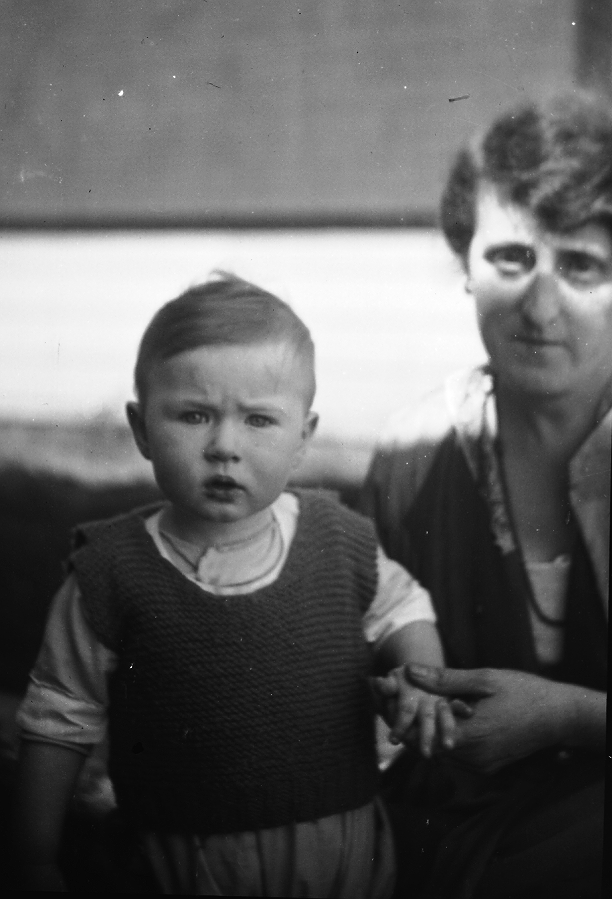
Jim and his mother Mary
EARLY YEARS
James
Aloysius Carey was born February 7, 1920 in San Francisco,
California. His parents, John Joseph Carey and Mary Josephine
Hickey were the children of Irish immigrants who settled in
Chicago. Jim was named James for his father's older brother,
and Aloysius for the Catholic parish in Chicago where his
parents married. He remembered, "That's where my name came
from ‑ my Mom and Dad were in St. Aloysius parish when
they were married."

Jim's
father worked as a credit manager for the City of Paris
department store in San Francisco. His mother was very active
in the Catholic Daughters organization, and later in the
Berkeley City Women's Club.
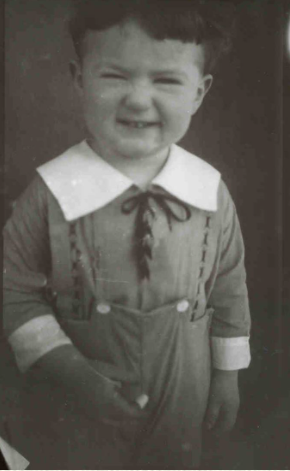
Jim's
two older brothers, John, age 9, and Tom, age 7, had been both
born in Chicago. The age difference between Jim and his two
older brothers helped develop a quiet independence in Jim.
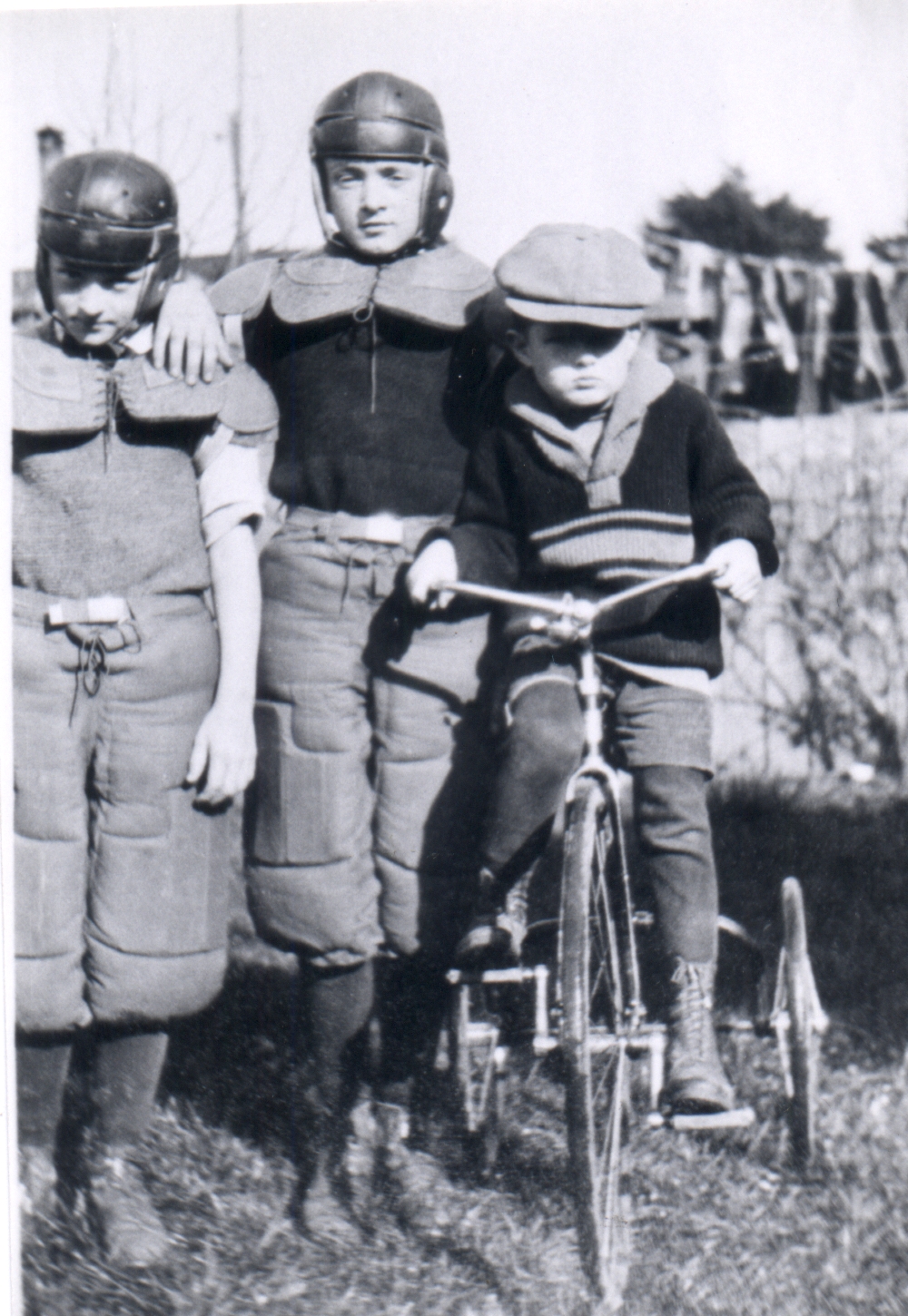
In a
taped interview in 1982, Jim remembered, "My earliest
recollection of anything is in about 1924 or 5. I remember the
Dole Pineapple Air Race from Oakland to Hawaii. I lived two
years in San Francisco, then moved to Berkeley, to 1427
Berkeley Way." Jim had no remembrance of his grandparents, as
they had died before his birth, or when he was very young. He
did remember, "In 1926, my Mother and myself, and my two
brothers, went back to Chicago for Grandma Hickey's funeral. I
was about six years old."
Some of
Jim's childhood memories were of going to the City of Paris
store and watching the trains run in the toy department while
his mother shopped. The family also went to the City of Paris
store at Christmas time to see the beautifully decorated tall
Christmas tree displayed there every year. The Carey family
Christmas was organized by Jim's mother. When the boys went to
bed on Christmas Eve, there were no signs of Christmas. That
night their mother would bring home a Christmas tree and
decorate it. When the boys woke up in the morning they would
find a fully decorated tree, complete with presents under it,
had magically appeared in the living room. One Carey family
tradition which continues to this day is the lavish use of
carefully hung icicles.
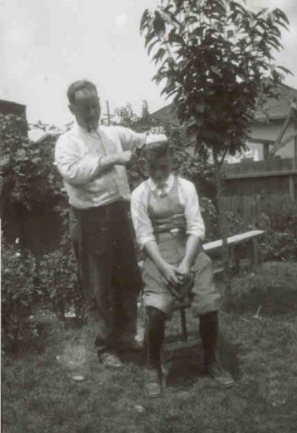
The
family next moved to 307 Rugby Avenue in Berkeley. Jim
attended St. Joseph's parochial school, where he met Ray
Hammons, his childhood best friend. They used to play across
the street in a vacant lot, and dig trenches there.
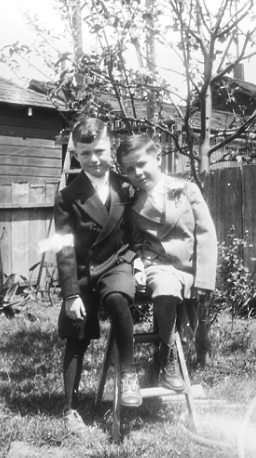
Jim's
father let him have a chemistry lab in the basement. Jim's
friends would encourage him to do chemistry experiments, like
making paint or exploding cans. He recalled, "We used to stick
sodium out on the street, and turn water on it. It would go
off with a big flash."
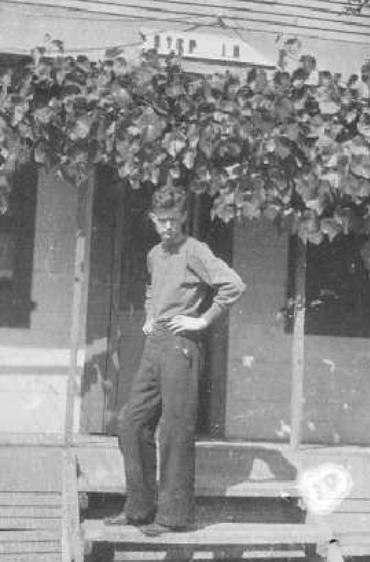
Jim was
a good student, with a great love of learning and reading. His
room had two beds, one of which was kept piled with books. His
mother wouldn't let the cleaning woman disturb Jim's books.
His mother was somewhat protective of her youngest child. He
achieved the rank of Eagle Scout. His father loved building
crystal radios, and Jim remembered that his Dad was always
building a bigger and better one. Jim recalled, "He was
building radios before they had networks - they just had a
little local station in San Francisco, and he built radios for
about three or four years, and I just naturally got into it
after that - mostly fixing the ones he built, I guess."
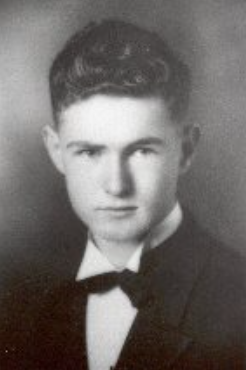
Jim
worked part time while in college as a courier for the credit
bureau where his brother Tom worked. His job was to walk
reports across Oakland. They liked him because he walked fast.
Next he worked from January 1939 to January 1942 as a
bookkeeper for the Bank of America. Among his group of
Catholic school friends, which included Ray Hammons, and Ray's
future wife, Patricia, was a girl whose father worked for the
Bank of America. One day her father asked Jim if he'd like to
work for the Bank of America. He said, "Sure.", not knowing
that a 42 year career was beginning. Jim attended UC Berkeley
until World War II broke out.
WAR YEARS
After
Pearl Harbor, the sheltered, intelligent 22 year-old college
student from Berkeley went to war. Jim never expected to come
back. His parents also expected that he would not return from
the war. Jim received his notice of selection on December 17,
1941. He was ordered to report for training to the Presidio at
Monterey on January 9, 1942.
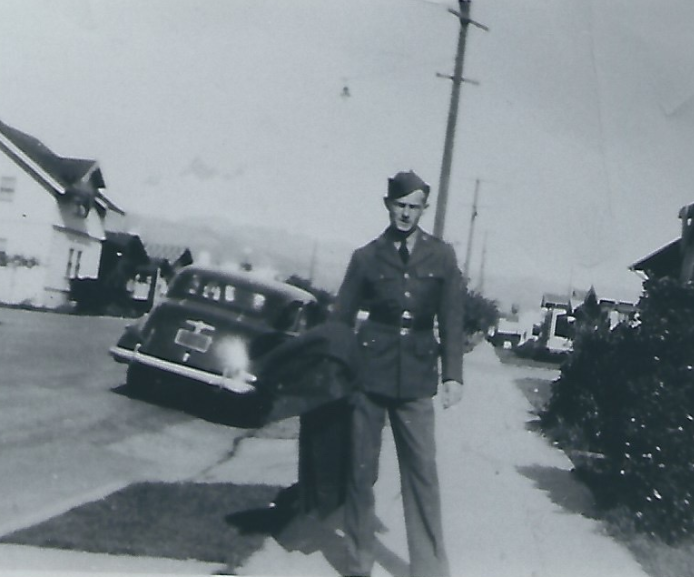
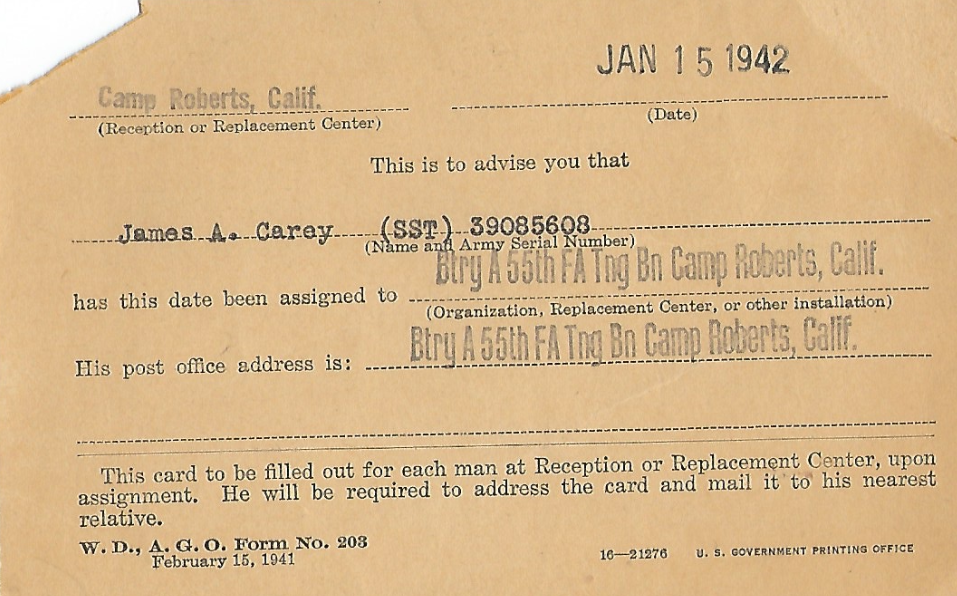
Six days
later he was sent to Camp Roberts for Desert Warfare training.
Here he "met" the legendary General Patton. Jim was driving a
jeep which broke down at an intersection. General Patton's
jeep pulled up to the intersection. General Patton stood up in
the back of the jeep and told Jim to "get that #@!*#! jeep out
of here!" Jim remembers staring at General Patton's
pearl-handled revolvers. He followed General Patton's orders
as fast as he could.
Jim
completed his basic training for Field Artillery in April.
Private James Carey was assigned to Battery B of the 49th
Field Artillery Battalion. In June he was promoted to Corporal
at Camp San Luis Obispo. In July he became a Sergeant, and in
September he was promoted to Staff Sergeant in the 7th
Division under the command of General Joseph Stilwell, also
known as "Vinegar Joe".
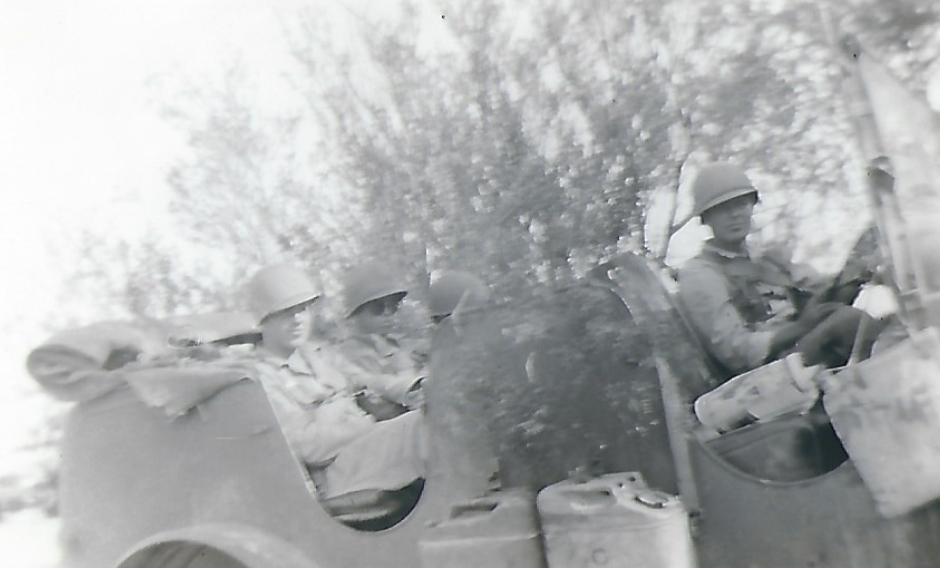
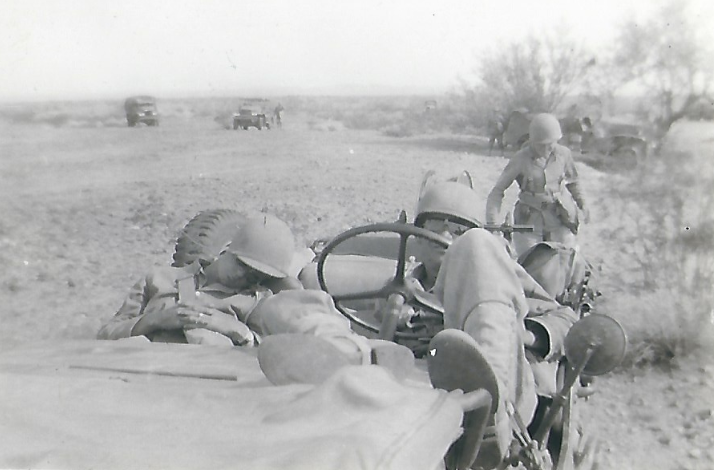
After extensive training in desert warfare for use in Africa,
they were sent to the Pacific to fight the Japanese. In April
of 1943, they sailed for the Pacific under the command of
General Albert E. Brown.
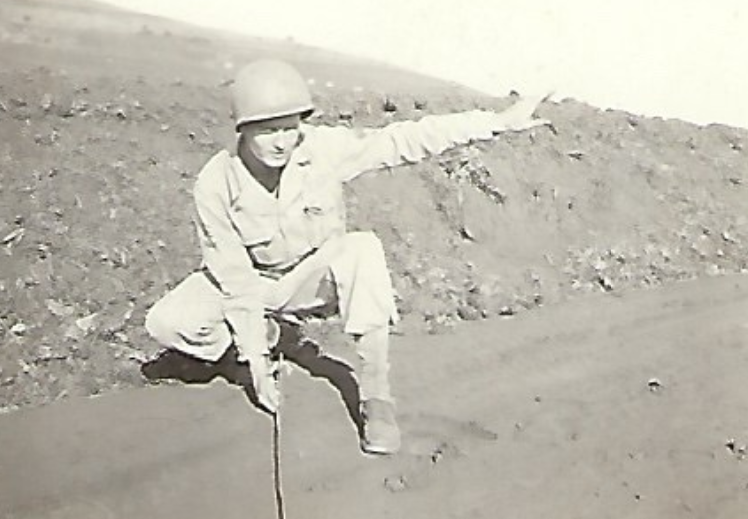
In a
book entitled "The 7th Did It the Hard Way" the history
of the 7th Division is told: "They hurriedly traded desert
clothing for arctic woolens and heavy leather boots. Though
trained for tropical warfare they had to be rushed to the
Arctic, because in those grim days of too little and too late,
they were the only troops we had ready." The ships sailed to
bleak Cold Bay, Alaska, where one of the Navy's first shore
bombardment fleets of old battleships and destroyers was
gathering."
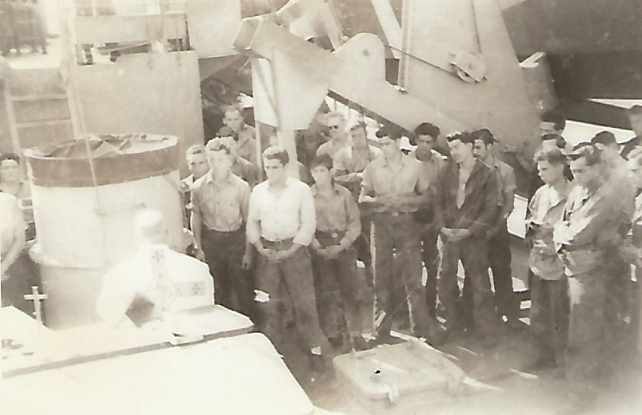
Jim's
experience in the Aleutians was miserable. He almost froze to
death, and got blood poisoning from a cut. The history
continues, "The division attacked Attu on May 11, 1943. Attu
was a fog-shrouded nightmare. Streams howled from the treeless
mountains down to the barren black beaches. For eleven days
some units waded through the ankle-deep, sticky mud. Almost
every hour, bullets and shells whistled over them, but in all
that time they saw no enemy soldier alive. There was no food
shortage on Attu the first night. After 36 hours, the division
barely had a foothold in Massacre Valley. Those 36 hours, and
the remainder of the 21 days of the Attu battle were endless
successions of treacherous climbs up icy mountainsides, of
sleeping in water-filled fox holes, feet swelling until boots
had to be cut away, sleeplessness, cold, misery from soaked
clothing and worn-out socks, frosted fingers, and rusted
weapons. The enemy fired from the fog, fell back, and fired
from the fog again."
At home
in Berkeley, Jim's mother and father worried about him. His
mother mailed him envelopes of Shredded Wheat, and other
cereals to keep him from starving. A baby boy born to Jim's
older brother John was named James in his honor.
Jim was
a artillery spotter, going in front of the front lines, and
calling down fire on enemy guns. This was an extremely
dangerous job. Jim's friend, Jerry Smith remembered with
admiration the calm voices of the artillery spotters,
directing fire as bombs exploded around them. In addition to
these duties, Jim and the other soldiers had the unpleasant
responsibility of burying dead Japanese soldiers in the frozen
tundra. The 7th Division "spent weary months cleaning up
battle debris, building bases, and burying the frozen dead in
the Attu mountains. All summer it dug Japanese stragglers out
of the caves and snowbanks, and guarded against their raids on
American supplies." When the Japanese soldiers saw that the
battle was lost, they committed suicide rather than be taken.
None survived the battle of Attu.
The
history continues: "Then the division reboarded its ancient
transports and went to Hawaii." The division rested and
received training in jungle warfare.
In
January 1944, they sailed for Kwajalein, in the Philippines,
and arrived there on February 1. "Boiling hot, Kwajalein was
only a little more that two miles long, a fourth as wide. Some
5,500 Japs were crowded on it, with defense works covering
every usable foot. At first no direct attack was made on
Kwajalein Island. Instead, small forces went ashore on
undefended Enubuj, two miles up the lagoon. There the division
artillery set up sixty guns, hub to hub, on the tiny islet.
While battleships offshore hurled in 16-inch shells, these
guns methodically pulverized the northwest end of Kwajalein,
until no blade of grass remained, then two regiments stormed
the beach. Five days later it was all over." Photos Jim took
show the enormous destruction.
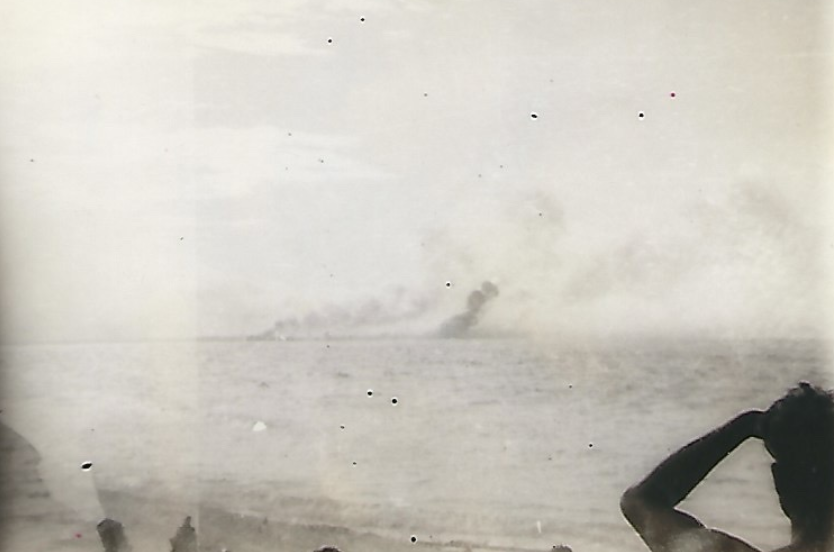
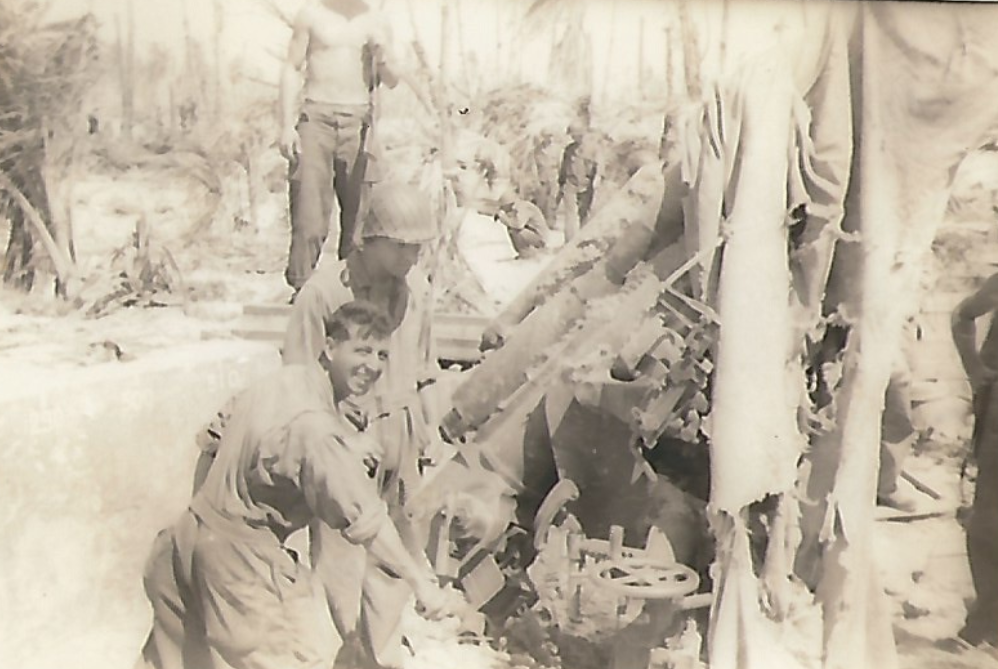
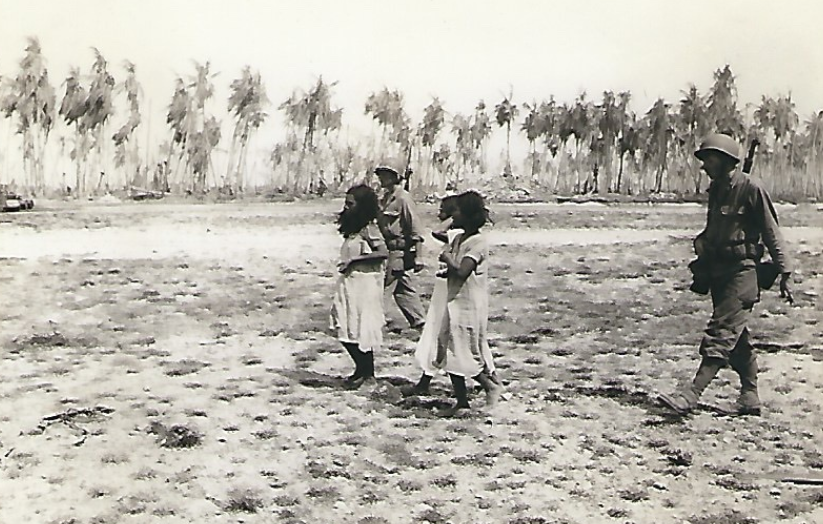
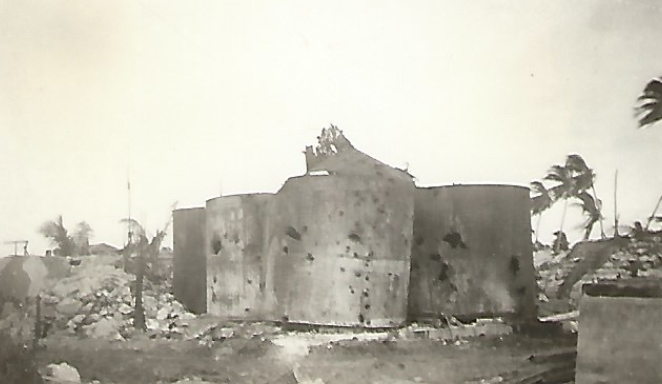
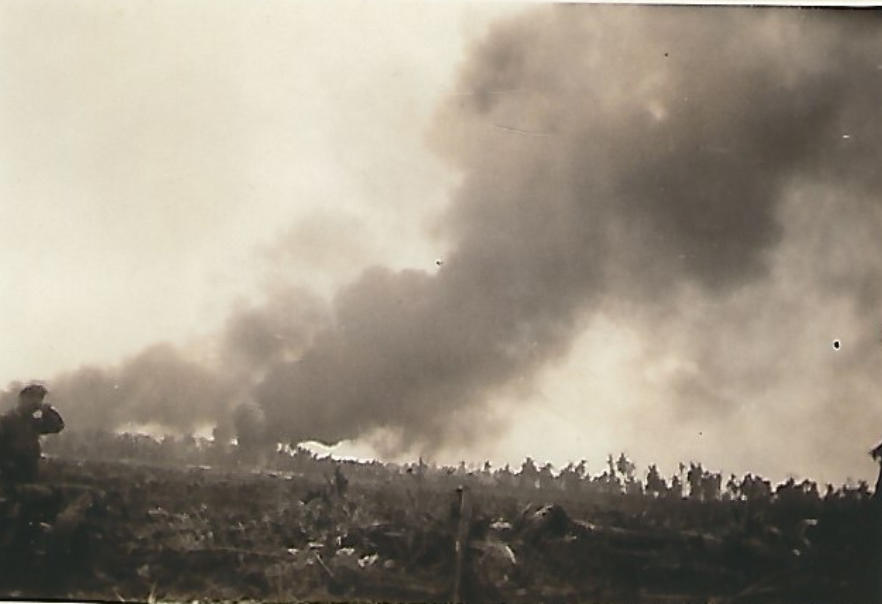
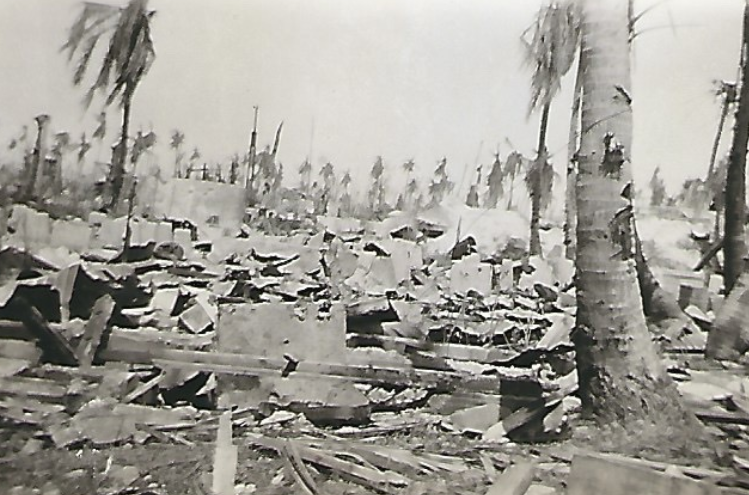
"Fuel Tanks - Enibuij"
(Photo by Jim
Carey)
"Oil fires
behind Japanese
line - Kwajalein" (Photo by Jim
Carey)
"Power Station - Enibuij Is" (Photo by Jim Carey)
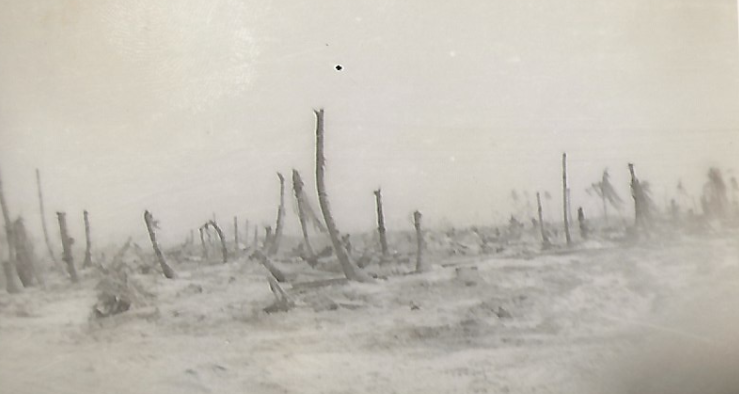
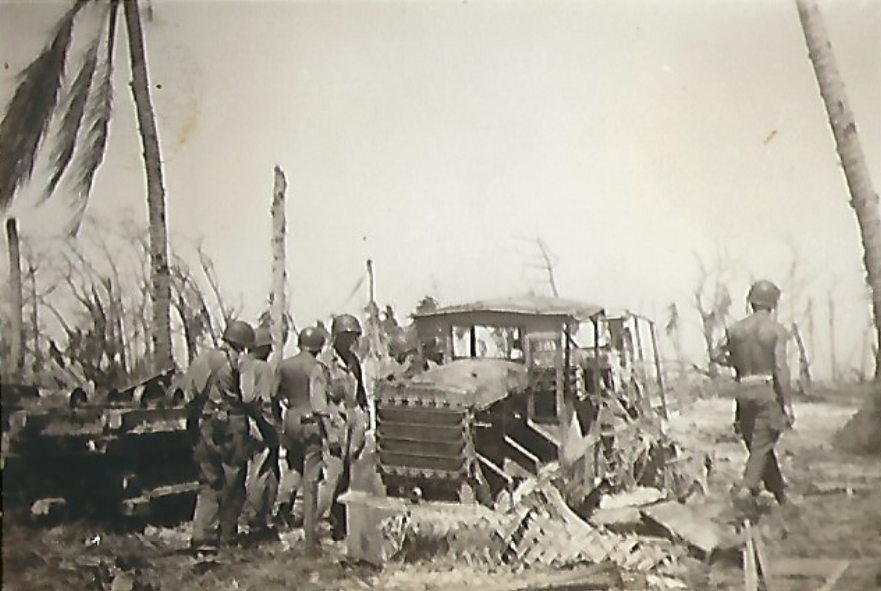
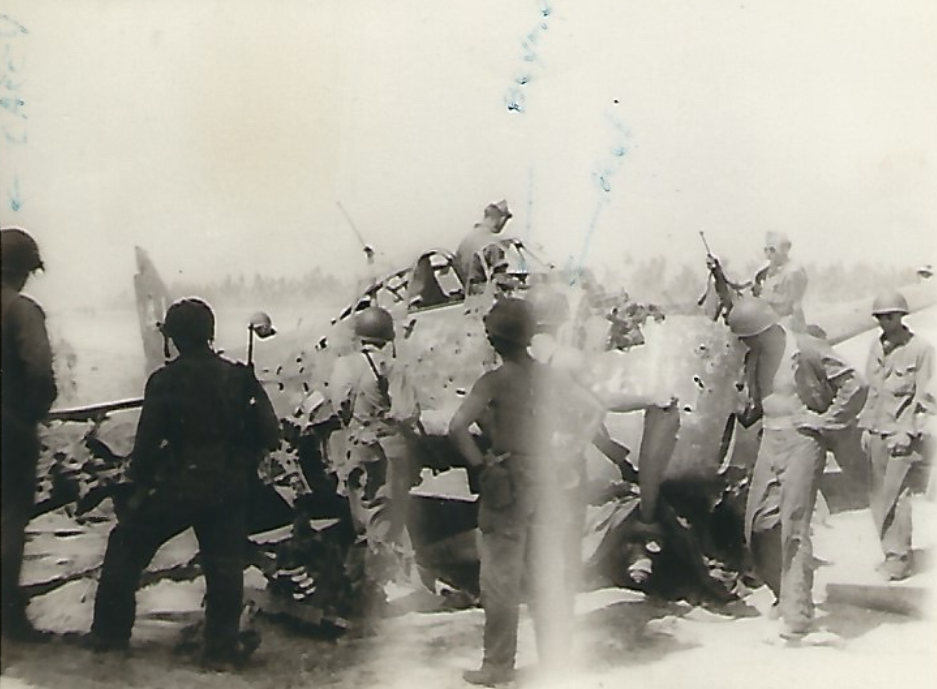
Once
again, burial duty was an unpleasant responsibility for Jim
and the other soldiers. The 7th Division again returned to
Hawaii.
Seven
months later, in September of 1944, the 7th Division was at
sea again. Its orders were changed as they sailed, and they
were assigned to the Leyte assault forces in the Philippines.
This was to be the most memorable battle of Jim's service. An
article in the Field Artillery Journal, April 1945, entitled
"Fifteen Days - The Defense of Damulaan" was kept by Jim, with
handwritten notes in the margins of the article. These
handwritten notes are included here in italics.
"Damulaan
was a small town on the western coast of Leyte in the
Philippines. The island was dominated by jungle-covered,
precipitous ranges, broad, swift rivers, sweeping, rice
paddy-filled plains, and a solid perimeter of perfect landing
beach. Initial landing in Leyte Valley shattered the Imperial
16th Division, the barbarians of Bataan's Death March, and
forced them to set up delaying defenses in the mountains."
Jim's Battery was involved in building more than fifty bridges
over narrow footpaths into the mountains. The winter rains
caused hardships, washing out most of the bridges so
laboriously built. Food shortages were common. The only
defensive position was at Damulaan, 17 miles north. On the
15th of November, Jim and the Baker Battery were sent north.
"Heavy
rain had fallen the night before Baker Battery headed north,
and it was able to make only half the distance to the
objective by nightfall. By early afternoon of the 16th, it was
in position, however, just south of the Bucan River. By
nightfall defensive fires had ben registered. Baker, with one
platoon of infantry attached to it, formed the right flank and
rear of the front line. The audacious little force had needled
the hide of the enemy and was now prepared to resist to the
limit of its powers. The defense of Damulaan had begun."
The next
morning was bright and sunny. Escaping natives warned of a
large mass of Japanese forces moving toward them. The Baker
Battery had done an excellent job of camouflage of its
position, and were not spotted by enemy bombers. No action
took place that night except for a few short fire fights. For
the next several days the Battery waited, trying to conserve
ammunition and supplies.
"By the
20th it was apparent that we were facing a large enemy force.
Conservative estimates indicated that at least 3,000 Japanese
troops were concentrating on the high ground to our front and
right flank. At our Observation Post (underlined)
the observers could look across the 600 yards-wide valley and
see the enemy constructing trenches, machine gun pits, and OPs
on the opposite ridge."
"The day
of the 23d had been quite peaceful. At 18:30 the Jap's
artillery went into action for the first time. As all contact
with our forward observers attached to the company was lost (handwritten notes -
B-1, Lt. Reardon, Carey, Keith, Patterson, Kruse, Kussels)
no fire could be placed on the invaders."
Jerry
Smith, Jim's friend, recalls Jim telling him about the battle:
"On Leyte, there was an artillery unit that had gone into a
little town called Damulaan, and there was supposed to be
infantry out in front of them, and there weren't. Somehow or
another they got separated from their infantry unit that was
supposed to be out in front of the artillery. The artillery
actually found themselves on the front line. Of course, Jim,
as a forward observer, was out in front of them, observing
artillery fire. The Japanese made a big charge, and completely
overran the position. Jim and another fellow were in a foxhole
up there spotting artillery. They were completely surrounded
by the Japanese. They were overrun in the charge, and there
was a Japanese officer up on top of the foxhole swinging a
samurai sword at them. He actually glanced off Jim's helmet.
He fired his carbine at the guy, and they got out of it. The
Japanese disappeared - they got artillery support. They, in
effect, called the artillery fire almost onto their own
position."
The
article continued the story: "Our forward observer section (B-1)
returned with all hands uninjured and accounted for except the
officer, who had told the section to return and had gone back
into the melee to assist some infantry men in rescuing a heavy
machine gun. At noon the officer (Reardon)
who had been with the company that had withdrawn during the
night reported into our CP. He had spent the night entirely
isolated from our own troops. The men he brought back with him
reduced the missing to less than a dozen."
On the
26th at about 04:00 Baker Battery was attacked. A suicide
party of eight Japanese soldiers attacked. "A wild, almost
hand-to-hand, melee erupted. A hot grenade battle followed.
One man (Joseph),
further removed from the rest, did use his carbine, and was
immediately spotted by the enemy, who killed him with a
grenade after he had emptied his clips. The explosions of
grenades grew to a roar as the Japs repeatedly attempted to
scale the three-foot bank on which the guns were in position.
Finally one made it, and was promptly killed beside the trail
of the first piece by the chief of the adjacent gun section
(Lenz)."
"The
next day was spent as the last few had been. Again our
observers and air spotters hammered away at all types of enemy
installations and personnel. By the night of December 1st it
was possible for us to place a simultaneous barrage around the
three land sides of our perimeter. The fifteen days at
Damulaan were ended. Infantry guts and artillery skill
together had held the sector."
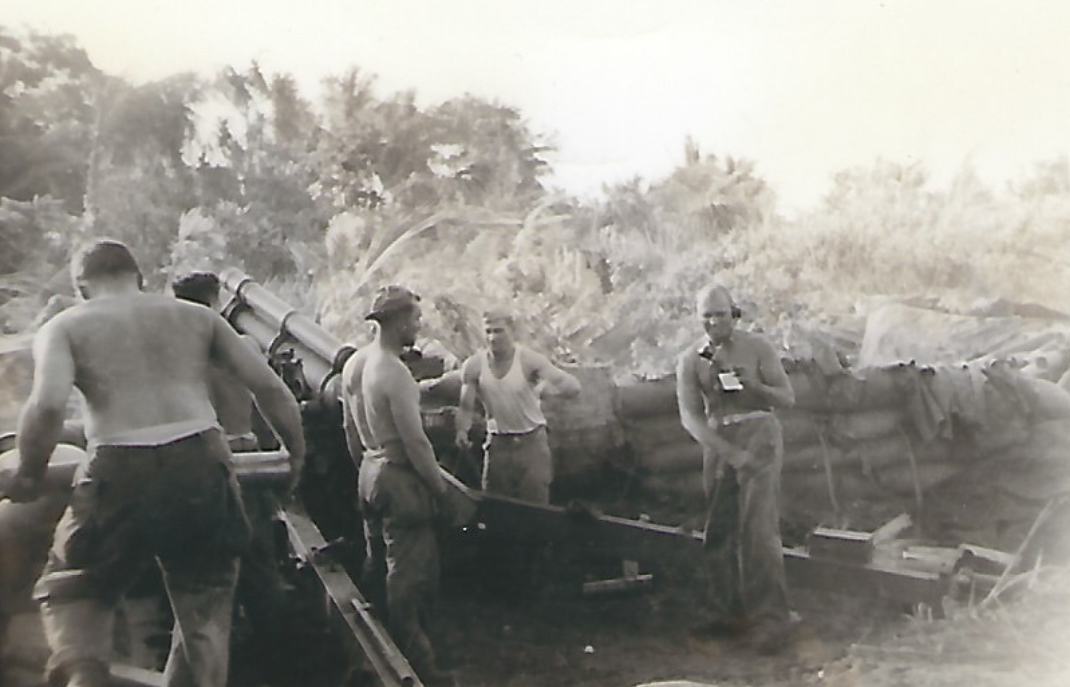
It was
here in the Philippines that Jim disarmed a Japanese officer,
taking his gun as a souvenir. The gun, a 1922 Browning 380
automatic, had the words in Ukrainian "Freedom Country"
engraved on the side. A gun expert speculated that the gun was
used by Ukrainian freedom fighters opposing the Communist
takeover. When the Communists succeeded, the Ukrainian freedom
fighters were pushed into China, and then into Japan. It was
there that the Japanese officer must have purchased the gun. A
weapon of this kind was considered a sign of rank in the
Japanese army. Jim brought it home from the war as a memento
of his experiences.
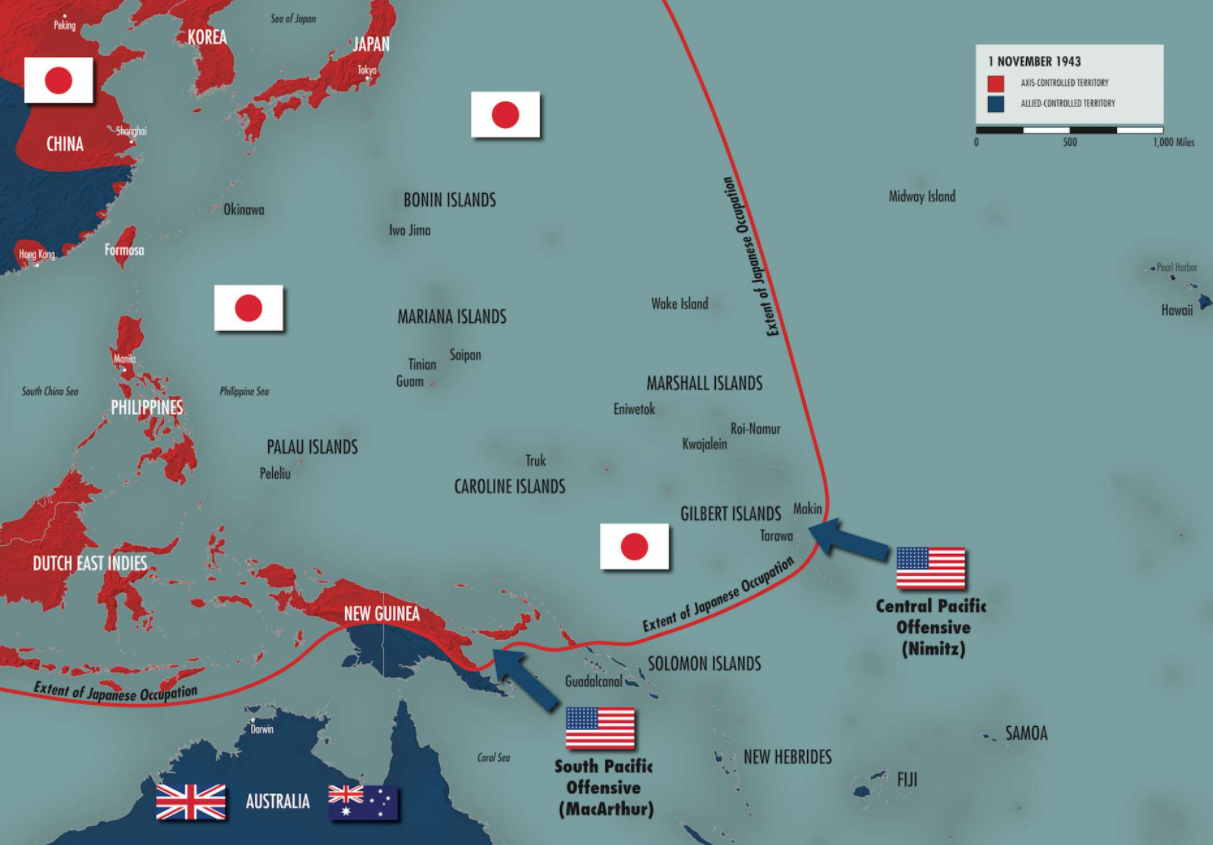
The 7th
Division rested only four days before proceeding to Okinawa.
There, according to "The 7th Did It the Hard Way" they
found that "the combination of hills, gullies, and cave tombs
could not have been better arranged for defense." Fred Lewis,
a fellow soldier said that Jim saved his life. They were in
the catacombs hunting down the Japanese. One jumped out and
was going to shoot Fred. Jim shot and killed the Japanese
soldier. Fred was grateful to Jim all his life.
It was
here in Okinawa that Jim received his Bronze Star for bravery.
With typical humility, he said it was for "working hard." For
a while the 7th's percentage of combat fatigue and shock cases
increased alarmingly, as men learned what it meant to fight
all day and to be shelled all night. The 7th Division spent
the next few months driving wedges into the enemy lines.
The 7th
Division was scheduled to be in the second wave of the assault
on Japan. Heavy casualties were expected. This became
unnecessary when Hiroshima was bombed, and the Japanese
surrendered. The war was over!
Jim had
enough service points to be eligible for discharge, and he
waited for his turn to go home. Jim's division had been
greatly reduced - only 20% had survived. He was given an
honorable discharge on October 17, 1945, and returned home to
a grateful country. The three years, nine months, and eight
days of war had been a memorable and frightening experience
for Jim. For years later he would sometimes wake up screaming
at night, as he relived painful memories. "After Attu, some
chair-borne columnist in this country said learnedly that the
soldiers of the 7th were so hardened that the Army was afraid
to turn them loose in the States again. That is just funny
now. Toward the end, men of the 7th had seen so much fighting
that they no longer bothered to pick up souvenirs. They
experienced so much of the real thing that they looked on
loud, tough-acting soldiers as pretty sad novices. When they
come home you will find them old field soldiers, quiet men
with a certain look in their eyes and a tightness around the
mouth, men who can't be pushed around and have no desire to
push anyone else around." (The 7th Did It the Hard Way)
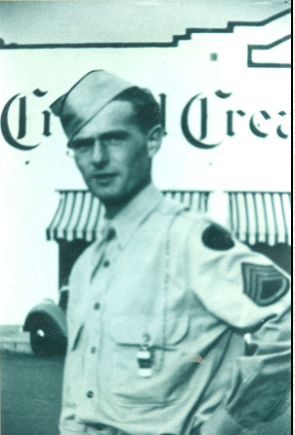
WORK AND FAMILY
Jim
returned home to Berkeley, a few years older, with a changed
view of the world. He said what he missed most, other than
family, was fresh food - meat, fruit, and vegetables. When
asked what he learned from the war, he laughed and said,
"Don't volunteer for anything!" Things had changed at home,
too. Jim returned to work at the South Berkeley branch of the
Bank of America. He met and became close friends with Jerry
Smith, a Navy veteran who had also served in the Pacific.
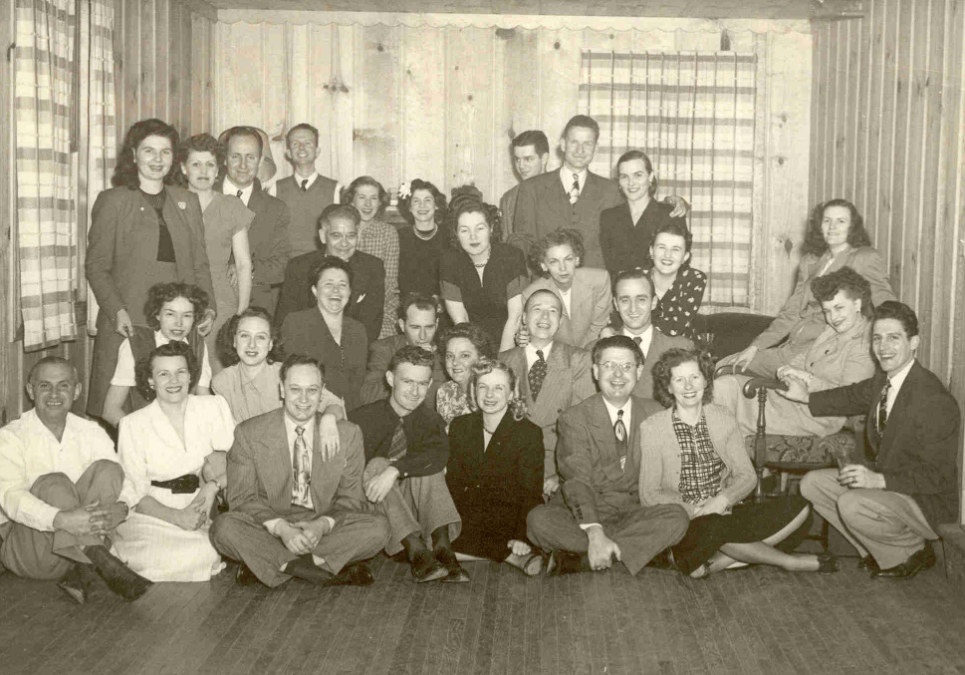
In 1947
Jim met Beulah Green, a traveling secretary for the Bank. She
remembers their first meeting, " I was the traveling secretary
for all eighteen branches, and I went to South Berkeley. They
introduced me to all these guys and gals - the tellers, and
they introduced me to Jim. He said hello, and turned back and
finished his work. I thought, well that's a happy married man
with about three kids!"
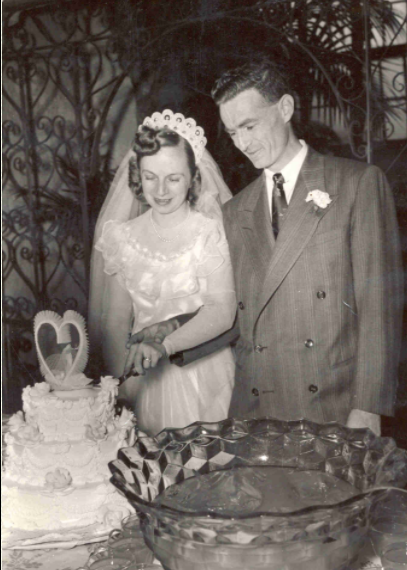
They
dated for about a year, and then Jim asked Beulah to marry
him. Beulah said, "I told him I was going back to Salt Lake,
and he said, No, you can't." They were married August 20, 1950
at St. Joseph's Church in Berkeley, and then had their
reception at the LDS Institute on LeConte Street. They young
couple moved into the upstairs of a new fourplex at 344 Key
Blvd. in El Cerrito. They stayed there for a few months, then
moved into a duplex. Next they moved to a house on Liberty in
El Cerrito, where their son, Charles Joseph was born. Jim took
a sample of Charlie's baby hair, and checked it under a
microscope to see if it would be straight or curly.
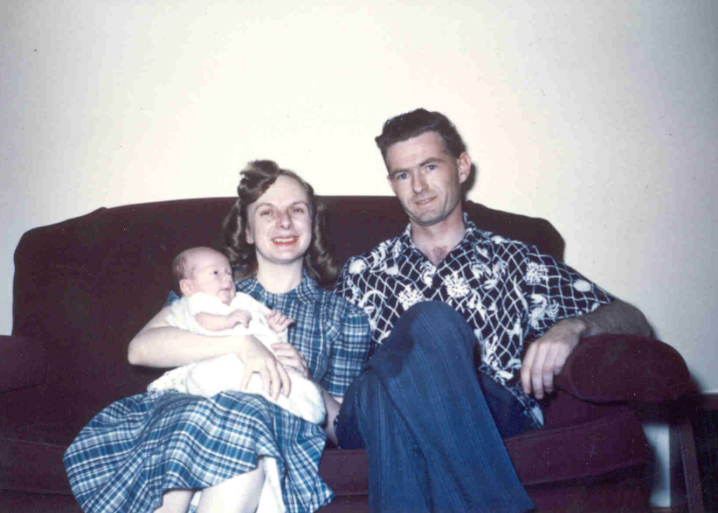
3 1/2
years later a daughter, Alice Anne, was born. Thirteen months
later, another son, Raymond Patrick, was born. Raymond came
into the world on Jim's birthday. Beulah went into labor, and
made it into the car, when it became apparent that birth was
imminent. Jim delivered the baby boy, and then carried the
mother and child back into the house. Jim called the doctor,
who asked if Jim would like to cut the cord, or wait for her
to do it. Jim opted to wait. Beulah remembers that Jim's face
was a pale shade of beige!
In 1953 Jim had been
promoted to Assistant Cashier at the South Berkeley branch,
and was pleased at his position as a bank officer. It was a
shock when he was called to a meeting, and told that he had
been selected to work on the bank's new computer system, ERMA.
Other members of the ERMA team had these comments: "We were
accepted into the very first ERMA program, and we had no idea
what it was."; "I'd never heard the word computer before I got
into the computer department."; "I said I'm going to be a
programmer, and they said what is that?, and I said I don't
know either, and there we were!". At that time there were less
than 500 computers in the world. Banks were being drowned in a
sea of checks and deposit slips. In 1955 Bank of America
worked with Stanford Research Institute to create a prototype
check processing computer to handle all this paper. They used
Magnetic Ink Character Recognition, or MICR, which allowed the
numbers on the bottom of checks to be read by machines. ERMA,
or Electronic Recording Method of Accounting, was born. In
1957 General Electric signed a contract to build thirty ERMA
computers for the Bank of America. The members of the ERMA
team were amazed that the instruction manual was only 26 pages
long. They spent long hours redesigning the ERMA system. In
1959 the completed system was unveiled in a televised press
conference, hosted by Ronald Reagan.
ERMA
worked in this way: The ERMA process began in the branch,
where staff encoded each check with the dollar amount. Then
the checks were sent to the ERMA center. Checks and deposit
slips were put through ERMA's sorter/readers, which read the
micro-encoded information, and sorted the items by account
number. ERMA's computer them posted the accounts. All account
information was stored on magnetic tape. High speed printers
produced reports for the branches, and monthly statements for
customers. The improvement in paper handling was tremendous. A
competent bookkeeper could post 250 accounts per hour. ERMA
could post 550 accounts per minute.
Tony
Russo, Jim's boss, remembers the first meeting of the ERMA
team. They sat down, and Jim pulled a slide rule out of his
briefcase, and Tony thought, "I've got to compete with him!?"
Many members of the team were nervous about this new step in
their careers. Tony recalled, "When I first saw the computer
my first instinct was to turn around and run like heck back to
where I came from. But then I looked around the room, and saw
the other operations officers that I had worked with in other
branches, and I thought, heck, if they can do it, I can do it.
So I stuck around, and I became a programmer. I think the
early days of the ERMA system were very exciting. Everyone
realized that they had a chance to be creative. Most of us
were branch operations officers, and we knew the frustrations
of our people in the branches. We were virtually turned loose.
We taught each other programming. We worked together on each
other's programs. There was a good sense of camaraderie. We
accepted this challenge to do a good job for the bank, and to
make the job much easier for our colleagues. It was a real
challenge that we all relished. We put in 18, 20, 30 hour
days."
Things
did not always run smoothly. Tony said, "The checks passed
over this wire. The wire guillotined them right across the
middle horizontally, and all the bottom halves went into the
pocket. All the top halves went flying across the room. So we
had to get the scotch tape out, and here were all these
bankers, on hands and knees on the floor, scotch taping the
tops and bottoms of all these checks to get them back together
again."
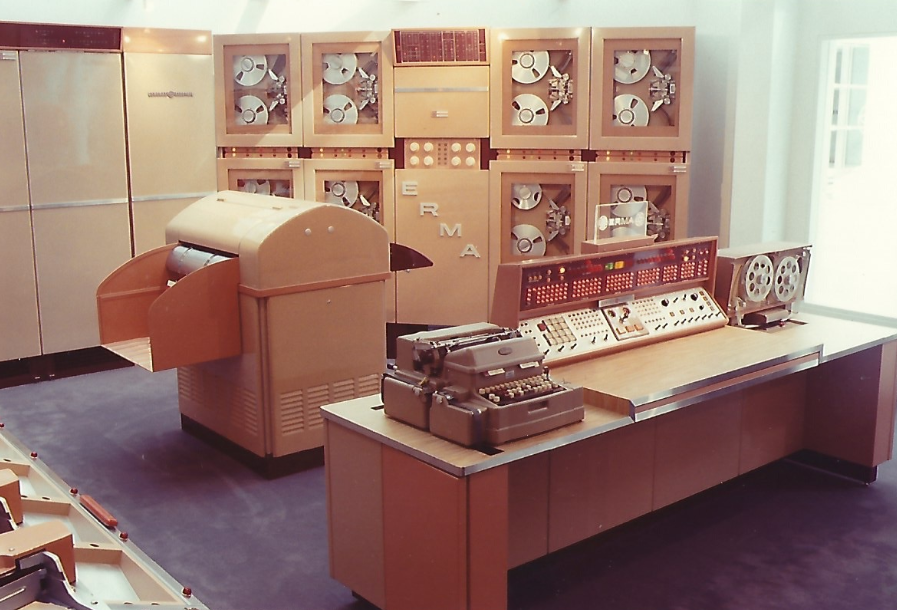
An
engineer from Stanford stated this about ERMA, "This was the
absolute beginning of the mechanization of business. That was
the breakpoint. It was not only a great thing for the bank, it
unloosed automation." ERMA was so successful that within a
decade 90% of all banks were using similar equipment. "Thanks
to the vision, the courage, and the perseverance of a few
dedicated pioneers the age of computerized banking had begun."
Jim was one of those pioneers. He developed a real talent for
programming. His daughter, Alice, remembers when she was a
teenager, and Jim help her solve a problem by flowcharting it.
One of the ways Jim coped
with the pressures and long hours of work was by taking short
naps. Colleagues remembered him eating his traditional peanut
butter sandwich (with no jelly) for lunch, and then taking a
fifteen minute nap, then waking up refreshed and ready to
work. His son Raymond drew pictures of his family, showing his
dad stretched out on the his bed, taking his usual after-work
nap. Co-workers remembered that when they stopped off at the
bar for a drink after work, Jim would say, "No thanks, I've
got to get home to my family."
Family
life was sometimes exciting, too. In 1958 Pleasant Hill was
flooded, and the Careys had to leave their home. Jim carried
Alice out, and the family stayed overnight on the second floor
of the grocery store next door.
In 1961
Jim was saddened by the death of his father. John J. Carey was
83 years old. Jim recalled, "It was hard to watch him get
older. He was always so funny. Those last few years he wasn't
funny any more."
Jim's
young family was growing. Charlie's earliest memories of his
Dad were of piggyback rides down the hall to bed. Charlie
recalled, "One thing I remember is out working in the garden.
I remember Dad making a sun dial and a scarecrow, and all
those kinds of things. That was in El Cerrito." Alice
remembered holding Dad's little finger when she had to cross
the street, him calling her "Sis", and getting piggyback rides
to bed. Alice recalled, "When I was growing up Dad took care
of all the scary things for me. He'd squish all the bugs. One
time I opened the back door, and found a snake curled up,
'smiling' at me. I screamed, and ran into the house. Then I
watched through the window, as Dad saved me by chopping up the
snake with a hoe." Raymond remembered going to bed, and giving
his Dad a hug, and being fascinated by his whiskers. Raymond
was also fascinated by Jim's tools. Unfortunately, sometimes
his fascination would lead him to wander off with the tools,
and then forget where he left them. A frantic search would
then ensue. It was at the house on Beth Drive that Jim built a
house for the family pet, a duck named Herkimer. He built a
little house with a ramp leading down into a "pond" - one of
the kids' old wading pools.
Bill
shared some early memories of his Dad. The first was when his
dad spanked him. He thought that he had the world's biggest
hands! He also remembers giving his dad a hug, and feeling his
face, and thinking, "Oooh, scratchy!" He was fascinated by his
dad's magnifying glasses, which Jim always had at the table
for closeup work. He also remembered his dad amazing him with
a small wood pipe cutout he made, which could do balancing
tricks with a belt.
The late
60s were tough years for Jim. The opening of another ERMA
center in Los Angeles meant long weeks away from his family.
His family became used to seeing him off at the airport.
Charlie said, "I remember going to the airport, and seeing the
Lockheed Electras he was always coming and going in. The
planes he took up and down to Los Angeles were all turbo
props." In January Jim and Alice flew to Los Angeles to pick
up a 1955 orange Mercury that had belonged to Beulah's father.
While they were there Jim got a phone call, saying that his
mother had a stroke, and passed away. Jim and Alice hurriedly
returned home for her funeral. Later that year, in December,
Jim's brother Tom died.
Jim
shared his love of chemistry with his family. His children
remembered watching as he set off homemade gopher bombs to
chase the rodents from their lawn. Alice recalls that one
Christmas Jim made a Christmas tree out of wire, and then put
it in a chemical solution. She watched in fascination as
silver icicles appeared on the tree. Jim also helped Alice get
an A on a sixth grade science assignment. He helped her gather
42 different chemical elements which they put in little
plastic bags, and stapled on a chart. She was the only one in
her class to have uranium, and classmates had fun playing with
the silvery mercury she brought in. Her teacher was
overwhelmed! Bill remembers his dad trying to make a nugget of
gold. Jim took old electronic parts which had a tiny amount of
gold in them, and tried to refine the gold out of them to make
a small nugget.
The
children were also amazed by their Dad's ability to do things
right. He could learn anything by reading a book - painting,
wallpapering, tiling. He always did things meticulously. Alice
remembers, "He didn't just slap paint on the wall. He would
tape the windows, and prepare the wall. He always took the
time to do things right. Later he wallpapered Michelle's room
for me. It was perfect - all the patterns were lined up
correctly. He taught me how to wallpaper, but I can't do it as
well as he could."
Alice
remembers, "I guess my favorite memory was the Gold and Green
Ball. The graduating girls were supposed to waltz with their
fathers. Dad didn't know how to waltz, and hated to be looked
at, but there we were, doing a two step around the dance
floor. I think my proudest moment was when I got a scholarship
to Berkeley, and he said, "She's got my brains."
RETIREMENT
Jim's
co-workers at the bank had many positive things to say about
Jim. Many programmers got their start under his tutelage. Tony
Russo remembered that in a tough, competitive business world,
Jim was exemplary for his integrity. Jim retired and tried to
take things easy. He went to lunch with old work friends like
Herm Moss. His first project was a brick edging lining the
front walkway. It took months and months to build, but when it
was done it was perfect.
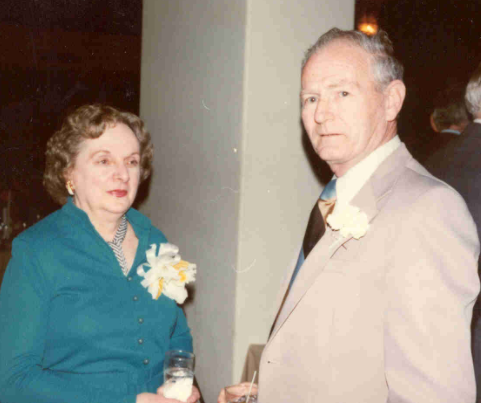
Jim and
Beulah took a trip in 1978 to pick up Raymond from his mission
in Germany. They took a cruise down the Rhine River. Later,
Charlie sent them on a trip to Hawaii. Jim enjoyed reliving
these trips through photos, videotapes, and music.
Jim's
first grandchild, Michelle Anne Boyd, was born in 1976. After
that, Adam Richard Boyd was born in 1979, then Megan Jean
Carey, Michael Carey, Kyle Carey, and Kira Carey. His last
grandchild, Daniel Carey was born in 1992. Michelle and
Adam remember these things about their Grandpa:
Michelle: "Grandpa would set up the ball clock to
entertain us. He also let me use his pedometer, and bounce on
the trampoline and measure it in miles. If I ever needed a
pencil or paper, all I needed to do was look where he sat. He
could do all sorts of things, like put up bricks. He could
paint and do tile. Grandpa and Grandma were funny. They would
always go together in the car, and argue about how to get
there, and where to go - any little detail. He liked to eat
Laura Scudder peanut butter, A&W root beer, and
weird-looking soups, like split pea and tomato."
Adam: "He liked to read, sleep, and play with the
remote control. When I was in the back room, he always used to
come in and show me things, like that little compass. I
remember he taught me how to lay bricks."
Jim like
to read and study many things. He seemed to know all kinds of
interesting and obscure facts. When Alice was working at the
library, and was stumped by the question, "What's the proposed
state fish of Hawaii?", she called him. He said, "Why that's
the Humu-humu-nuka-nuka-apuaa." He loved to study maps, and do
calculations on his ever-present yellow legal pads. His
grandchildren always knew that if they were stumped on a
homework question, they could call Grandpa for the answer.
Alice also enjoyed talking with her father about her
discoveries when she worked on their common Irish ancestry. He
would help translate Latin passages for her, and tell her
stories about his parents.
Jim also
loved gadgets. He loved to put together Heathkits. He owned a
variety of calculators for doing his calculations. Charlie
could remember a gadget from his childhood, "Dad had a puptent
kind of antenna. It was an arrangement of sticks, about the
size of a box kite, and triangular shape. It had copper wire
wrapped around it. You could see one channel in one direction,
and turn it another way for another channel. He ended up
putting it up in the attic, and pointing it some way that
worked best for most things." Jim had a scanner he would
listen to, and then call Bill and warn him about things going
on in his area. Jim would amuse his youngest grandson, Daniel,
by showing him his talking clock, or making the bird come out
of the cuckoo clock. He loved to show visitors his latest
gadgets.